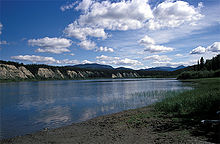
Johnsons Crossing [1] [2] [3] or Johnson's Crossing [3] is a settlement in Yukon, Canada. It is located at historical mile 836 of the Alaska Highway, at the junction of the Canol Road where the highway crosses the Teslin River.

Johnsons Crossing [1] [2] [3] or Johnson's Crossing [3] is a settlement in Yukon, Canada. It is located at historical mile 836 of the Alaska Highway, at the junction of the Canol Road where the highway crosses the Teslin River.
| Climate data for Johnsons Crossing | |||||||||||||
|---|---|---|---|---|---|---|---|---|---|---|---|---|---|
| Month | Jan | Feb | Mar | Apr | May | Jun | Jul | Aug | Sep | Oct | Nov | Dec | Year |
| Record high °C (°F) | 7.2 (45.0) | 12.2 (54.0) | 12.8 (55.0) | 20.6 (69.1) | 34.0 (93.2) | 32.2 (90.0) | 31.1 (88.0) | 31.0 (87.8) | 25.6 (78.1) | 18.0 (64.4) | 8.9 (48.0) | 7.5 (45.5) | 34.0 (93.2) |
| Average high °C (°F) | −11.7 (10.9) | −8.8 (16.2) | 0.5 (32.9) | 6.9 (44.4) | 13.4 (56.1) | 18.8 (65.8) | 20.6 (69.1) | 18.3 (64.9) | 12.1 (53.8) | 3.9 (39.0) | −6.4 (20.5) | −10.4 (13.3) | 4.8 (40.6) |
| Daily mean °C (°F) | −16.2 (2.8) | −14.6 (5.7) | −6.2 (20.8) | 0.4 (32.7) | 6.4 (43.5) | 11.2 (52.2) | 13.6 (56.5) | 11.4 (52.5) | 6.4 (43.5) | 0.0 (32.0) | −10.5 (13.1) | −14.8 (5.4) | −1.1 (30.0) |
| Average low °C (°F) | −20.7 (−5.3) | −20.4 (−4.7) | −12.9 (8.8) | −6.1 (21.0) | −0.7 (30.7) | 3.6 (38.5) | 6.6 (43.9) | 4.5 (40.1) | 0.7 (33.3) | −3.8 (25.2) | −14.5 (5.9) | −19.3 (−2.7) | −6.9 (19.6) |
| Record low °C (°F) | −52.2 (−62.0) | −51.2 (−60.2) | −40.6 (−41.1) | −27.5 (−17.5) | −11.1 (12.0) | −3.9 (25.0) | −2.2 (28.0) | −4.0 (24.8) | −16.0 (3.2) | −31.0 (−23.8) | −42.0 (−43.6) | −55.0 (−67.0) | −55.0 (−67.0) |
| Average precipitation mm (inches) | 29.9 (1.18) | 20.0 (0.79) | 13.6 (0.54) | 8.8 (0.35) | 22.8 (0.90) | 40.4 (1.59) | 56.2 (2.21) | 45.0 (1.77) | 52.0 (2.05) | 39.1 (1.54) | 34.8 (1.37) | 28.4 (1.12) | 391.0 (15.39) |
| Average rainfall mm (inches) | 0.0 (0.0) | 0.0 (0.0) | 0.0 (0.0) | 1.8 (0.07) | 22.2 (0.87) | 40.4 (1.59) | 56.2 (2.21) | 45.0 (1.77) | 49.9 (1.96) | 25.0 (0.98) | 2.0 (0.08) | 0.0 (0.0) | 242.6 (9.55) |
| Average snowfall cm (inches) | 29.9 (11.8) | 20.0 (7.9) | 13.6 (5.4) | 6.9 (2.7) | 0.6 (0.2) | 0.0 (0.0) | 0.0 (0.0) | 0.1 (0.0) | 2.1 (0.8) | 14.1 (5.6) | 32.8 (12.9) | 28.4 (11.2) | 148.5 (58.5) |
| Average precipitation days (≥ 0.2 mm) | 9.4 | 6.9 | 5.6 | 3.9 | 8.6 | 12.2 | 14.6 | 12.2 | 12.8 | 12.6 | 13.4 | 10.1 | 122.2 |
| Average rainy days (≥ 0.2 mm) | 0.0 | 0.0 | 0.0 | 1.1 | 8.5 | 12.2 | 14.6 | 12.1 | 12.6 | 8.2 | 0.9 | 0.0 | 70.1 |
| Average snowy days (≥ 0.2 cm) | 9.4 | 6.9 | 5.6 | 2.9 | 0.4 | 0.0 | 0.0 | 0.1 | 0.4 | 5.5 | 12.5 | 10.1 | 53.9 |
| Source: Environment Canada Canadian Climate Normals 1981–2010 [2] | |||||||||||||
| Year | Pop. | ±% |
|---|---|---|
| 1981 | 13 | — |
| 1986 | 18 | +38.5% |
| 1991 | 17 | −5.6% |
| 1996 | 5 | −70.6% |
| 2001 | 20 | +300.0% |
| 2006 | 15 | −25.0% |
| 2011 | 15 | +0.0% |
| 2016 | 10 | −33.3% |
| 2021 | 10 | +0.0% |
| Source: Statistics Canada [4] [5] [6] [7] [8] [1] [9] [10] | ||
In the 2021 Census of Population conducted by Statistics Canada, Johnsons Crossing had a population of 10 living in 3 of its 12 total private dwellings, a change of 0% from its 2016 population of 10. With a land area of 21.98 km2 (8.49 sq mi), it had a population density of 0.5/km2 (1.2/sq mi) in 2021. [10]
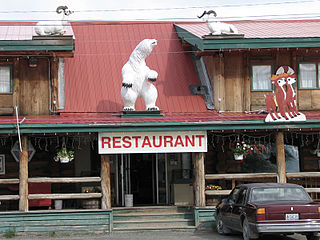
Beaver Creek is a community in Yukon, Canada. Located at kilometre 1870.6 of the Alaska Highway, 1 NM southeast of Beaver Creek Airport and close to the Alcan - Beaver Creek Border Crossing, it is Canada's westernmost community. The community's main employers are a Canada Border Services Agency port, the White River First Nation and a number of tourist lodges.
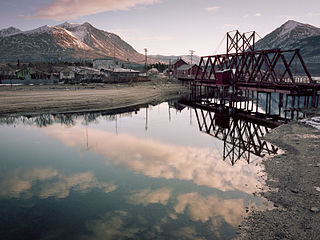
Carcross, originally known as Caribou Crossing, is an unincorporated community in Yukon, Canada, on Bennett Lake and Nares Lake. It is home to the Carcross/Tagish First Nation.

Haines Junction is a village in Yukon, Canada. It is at Kilometre 1,632 of the Alaska Highway at its junction with the Haines Highway, hence the name of the community. According to the 2021 Census, the population was 688. However, the Yukon Bureau of Statistics lists the population count for 2022 as 1,018.
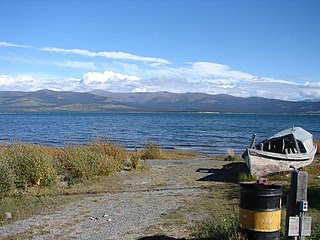
Burwash Landing is a small community, at historical mile 1093 on the Alaska Highway, in Yukon, Canada along the southern shore of Kluane Lake.

Carmacks is a village in Yukon, Canada, on the Yukon River along the Klondike Highway, and at the west end of the Robert Campbell Highway from Watson Lake. The population is 493. It is the home of the Little Salmon/Carmacks First Nation, a Northern Tutchone-speaking people.
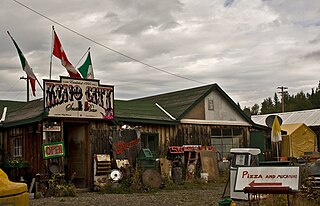
Keno City is a small community in Yukon, Canada at the end of the Silver Trail highway. Keno City was the site of a former silver-lead mining area proximal to Keno Hill. Keno City is 13 kilometres away from Elsa, Yukon, which is owned by Hecla mining who currently own and operate the various Ag-Pb-Zn deposits in the Keno Hill area. Rich silver and lead ore deposits were found on Keno Hill in 1919, and since then the population of the community has fluctuated in response to the mining activity in the area. When in 1989 United Keno Hill closed the mines, literally overnight, the people in the Keno area who decided to stay chose a more sustainable economy: tourism. They successfully marketed Keno City as a quiet, tranquil community.

Mayo is a village in Yukon, Canada, along the Silver Trail and the Stewart River. It had a population of 200 in 2016. The Yukon Bureau of Statistics estimated a population of 496 in 2019. It is also the home of the First Nation of Na-Cho Nyäk Dun, whose primary language is Northern Tutchone. Na-Cho Nyäk Dun translates into "big river people."
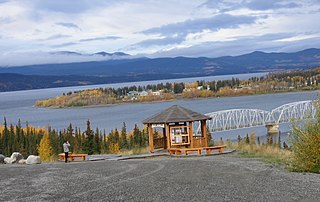
The community of Teslin includes the Village of Teslin in Yukon, Canada. Teslin is situated at historical Mile 804 on the Alaska Highway along Teslin Lake. The Hudson's Bay Company established a small trading post at Teslin in 1903.
Pelly Crossing is a community in Yukon, Canada. It lies where the Klondike Highway crosses the Pelly River.
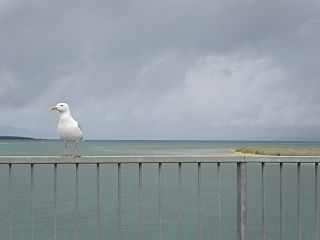
Tagish is an unincorporated community in Yukon, Canada. It is 30 kilometres (19 mi) east of Carcross, Yukon, on the Tagish Road at the northern end of Tagish Lake. The greater Tagish area also includes the Tagish Estates, Tagish Beach and Taku subdivisions, the latter two developed for cottages but now serving for many year-round homes. Tagish Beach and Taku have their own community hall. The Tagish Road was built in 1942 as part of an oil pipeline project, and the community sprouted around a bridge built over the narrow water between Tagish Lake and Marsh Lake.

Champagne Landing or Champagne Landing 10 is a First Nations settlement in Yukon, Canada. It is located on the Alaska Highway. Its residents are citizens of the Champagne and Aishihik First Nations.

Destruction Bay is a small community on the Alaska Highway in Canada's Yukon on Kluane Lake.
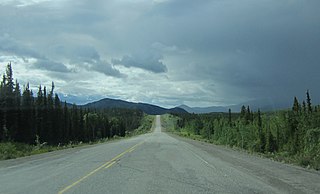
Ibex Valley is a hamlet in Canada's Yukon. The hamlet is considered a local advisory area with an advisory council providing local government. Its population in 2001 according to the Canada 2001 Census was 315.
Mount Lorne is a hamlet in Canada's Yukon. The hamlet is considered a local advisory area with an advisory council providing local government.
Marsh Lake is an unincorporated community on the Alaska Highway on the shores of Marsh Lake southeast of Whitehorse in Canada's Yukon. The area was organized in 2001, as a local area council to help the residents with some form of municipal government.
Upper Liard is a chiefly First Nation settlement immediately west of Watson Lake in Canada's Yukon. It is situated at historical mile 642 of the Alaska Highway. Most of the residents are citizens of the Liard River First Nation, who also prominently populate the Two Mile area just north of Watson Lake.

Stewart Crossing is a settlement in Yukon, Canada located on the Stewart River. It is about 179 km east of Dawson City on the Klondike Highway, near the junction with the Silver Trail, from which it is about 53 km (33 mi) southwest of Mayo. A Yukon government highway maintenance camp and a highway lodge are the most prominent facilities at Stewart Crossing. The settlement is named for where the Klondike Highway, crossed the Stewart River by means of a ferry from 1950 until completion of a bridge in the mid-1950s.

Swift River is a settlement in the Canadian territory of Yukon, primarily a service stop on the Alaska Highway at historical mile 733. The radius of the area is estimated to be about 22.71 square kilometres ). The only permanent population owns and operates, or is employed at, the area's commercial highway establishment. Other residents are transient, working at the Yukon government's highway maintenance camp.
Two Mile Village is an Indian settlement in southeast Yukon, Canada. It is located on the Robert Campbell Highway, approximately 12 km (7.5 mi) northwest of Watson Lake. The settlement is recognized as a census subdivision by Statistics Canada.
Two and One-Half Mile Village is an Indian settlement in southeast Yukon, Canada. It is located on the Robert Campbell Highway, approximately 16 km (9.9 mi) northwest of Watson Lake. The settlement is recognized as a census subdivision by Statistics Canada.
Coordinates: 60°29′21.93″N133°17′40.33″W / 60.4894250°N 133.2945361°W